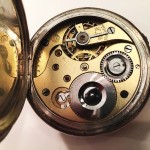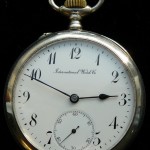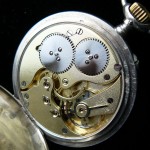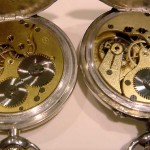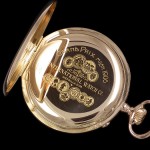Calibre 56, also known as the “Schaffhausen” calibre, was a Savonette movement (with the winding mechanism and therefore the crown at 3 o’clock). It was first manufactured in 1889, a year after the debut of Calibre IWC. Initially, this movement was paired with the Calibre 57, a Lépine version that was introduced in 1890.
Another Savonette movement of similar design, Calibre 58, was introduced in 1889. That calibre, too, subsequently was paired with Calibre 57. Both Calibres 57 and 58 were known as “Americaine” calibres, for reasons not specifically known today. However, 1,200 Calibre 57 and 58 movements were produced exclusively for the U.S. market from 1889 through 1891.
Calibre 57 in many ways was a less expensive Calibre 52. with a half-plate rather than a three-quarters plate. However, there were identical size variations (18 or 19 ligne, and heights of 5, 6, 6 1/2 or 7 mm), and most parts were interchangeable. Like the Calibre 52, the Calibre 57 sometimes had a crown setting mechanism and sometimes a indentation that first had to be depressed before setting.
While watches with the Calibre 57 movement were priced less than those with a Calibre 52, the Calibre 57 still was an excellent movement. It had a bimetallic balance, a Breguet overcoil, and either classic lever or fine adjustment. 119,430 were made from 1890 to 1931; in addition, 19,100 Calibre 58s were produced.
The IWC Calibre 55, shown here, was a stripped-down version of the Calibre 54. It, like the 54, was slightly smaller at 18 (rather than 19) lignes in diameter. Its most visible characteristic is that it does not have separate cock fixing the escape wheel, but instead the three quarters plate is enlarged. It also had a flat balance spring, rather than a split compensation balance with a Breguet overcoil. The example shown here is one of the first 500 produced in 1888.
Shown here is a typical Calibre 57 Lépine watch with a classic dial with Breguet style numerals. The movement characteristics are well illustrated in the second image. Like its predecessors, the Calibre 57 does not have a separate escape wheel cock but rather an extended plate.
All Calibre 57s were not created equal. The movement at left has fine adjustment but the one at right has a simple classic lever adjustment. However. the one at right has its jewels set in chatons. After about 1920, improved production engineering allowed jewels simply to be pressed without chatons, but screwed chatons were offered for decoration only for a nominal extra charge.
Many Calibre 57s were sold with an engraved dust cover, showing IWC’s Grand Prix award from the 1906 Milan exposition, Esposizione Internazionale del Sempione. However, the engraving was done for marketing purposes and does not make the watch more valuable than other IWC models.


